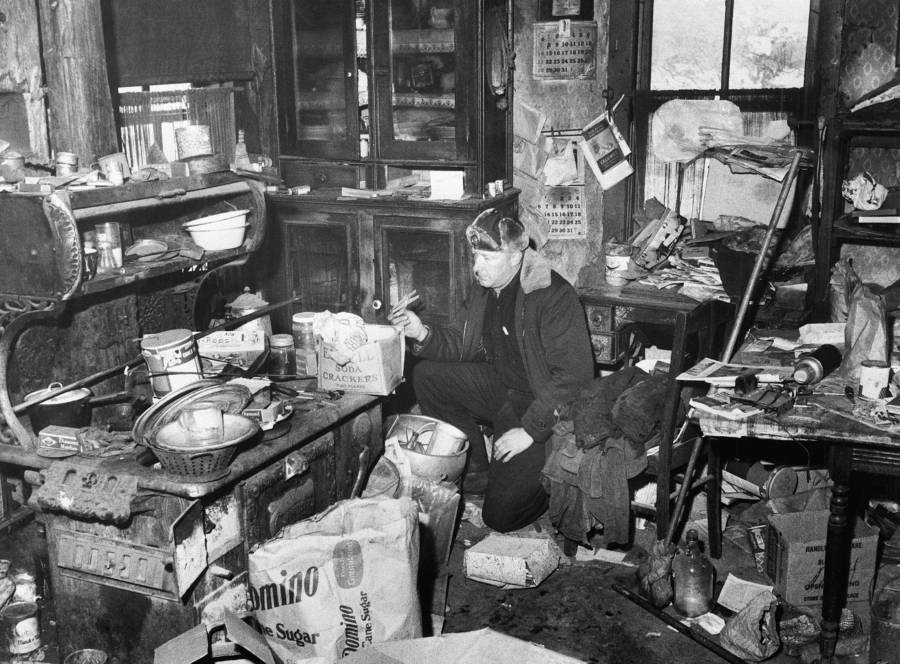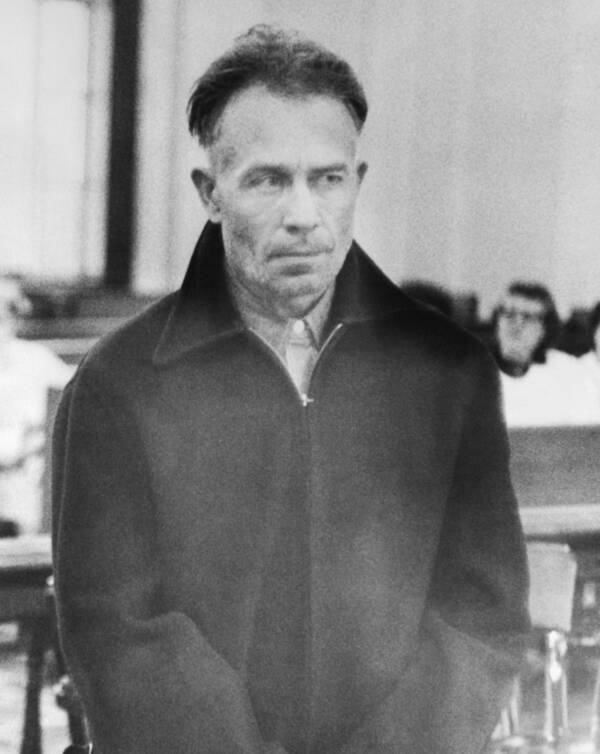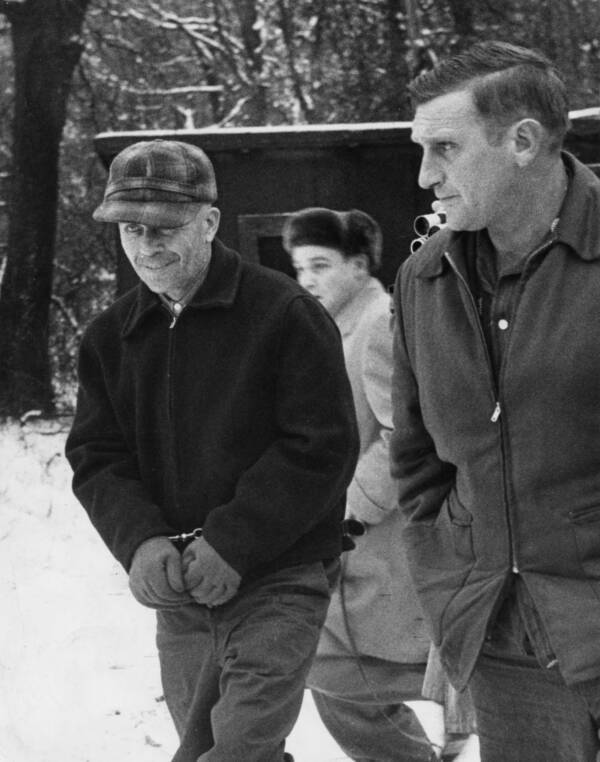After Ed Gein's mother Augusta Wilhelmine Gein died of a stroke, he became a murderer and body snatcher, hoping to create a "woman suit" from corpses.
Known as the “Butcher of Plainfield,” Ed Gein was one of the world’s most twisted serial killers. A murderer and grave robber who used his victims’ body parts to craft furniture and clothing, Gein’s horrific crimes served as inspiration for some of the most well-known horror films of all time: The Silence of the Lambs, The Texas Chainsaw Massacre, and Psycho. The last movie is of particular note, however, because it was not just Ed Gein who inspired the film, but his mother Augusta Wilhelmine Gein as well.
Raised in a family of German Old Lutherans, Ed Gein’s mother grew up believing that every human thought and deed was infected with sin — and she passed this belief onto her son as well. She instilled in her son that sex was evil and that women were instruments of the Devil.

Bettmann/Getty ImagesThe interior of Ed Gein’s home. Though he kept some rooms pristine in memory of his mother, the rest of the house was a mess.
Despite Augusta Gein’s fervently religious and overbearing nature, Ed was completely obsessed with his mother, much like Norman Bates in Psycho. And after Augusta died from a stroke, Ed was utterly devastated.
Refusing to believe his mother was truly gone forever, he became chillingly determined to bring her back. In a desperate attempt to quasi-resurrect his mother, Ed turned to murdering women and stealing corpses from a nearby graveyard so he could create a “woman suit” and “become” his mother.
While Ed Gein’s mother was alive, she had always hoped to protect her son from evil. But in the end, her obsession with purity and sin — and her determination to isolate her son from all that was wicked — fatefully warped her son’s perspective of the world. And she unwittingly raised a depraved killer.
How Religious Fervor Turned Ed Gein’s Mother Into An Overbearing Force
Born Augusta Wilhelmine Lehrke in 1878, Ed Gein’s mother grew up as one of eight children in a family of German immigrants from Prussia, who had settled in La Crosse, Wisconsin. Like many other Old Lutherans, the Lehrkes left Prussia as part of a mass exodus. It’s important to note their faith, Old Lutheran, was far more conservative than the mainstream Lutheran faith.
According to their beliefs, all humans were full of sin, both in their thoughts and actions. Humans, they said, were infected with immoral motives. Because of this, they also believed that all humans deserved to burn in Hell.
On December 11, 1900, around the age of 22, Augusta married a man named George Philip Gein, another child of German immigrants who had moved to Hamburg, Wisconsin with his family. Two years later, Augusta and George welcomed their first child, a son they named Henry George Gein.

Bettmann/Getty ImagesAlso known as the “Butcher of Plainfield,” Ed Gein murdered two women and robbed untold graves in 1950s Wisconsin — then turned their skins into keepsakes.
Per the New Zealand Herald, George Gein worked a series of odd jobs — taking gigs as a carpenter and a tanner — but he struggled to stick with anything for long. This was largely due to his struggles with alcoholism.
His wife, meanwhile, ran a small grocery store and tried to keep the family home in order. But in time, she began to resent her husband. However, Augusta’s religious beliefs prevented her from divorcing him, so her resentment steadily grew. Soon enough, she developed a deep hatred of men in general — and dreamed of giving birth to a daughter.
Augusta did not get her wish. Instead, when the couple welcomed their second child in 1906, they were presented with a second son. They named him Edward Theodore Gein. Not wanting her child to grow up to be the type of man she so loathed, Ed Gein’s mother raised him with an overbearing protectiveness that slowly warped his perception of the world.
Augusta Wilhelmine Gein Isolates Her Son From The World
Having grown sick of La Crosse, which Augusta considered to be a hotbed of sin, Augusta demanded that the family pack up and move to an isolated farmhouse near the rural town of Plainfield, Wisconsin in 1915.
At the Gein house, away from the sinners in the city, she could raise young Ed and Henry to become the pure men she wanted them to be. The young boys were forbidden to leave the farm except to attend the nearby Roche-a-Cri grade school, which was a one-room building with only 12 students.
According to a report from Radford University, Ed was known to be a voracious reader, but he struggled to fit in with the other children. He was shy and had a lazy eye, as well as a lesion on his tongue that affected his speech. Other kids at his school often shunned him, and even when he tried to make friends, Ed Gein’s mother punished him for socializing.
Augusta was worried that Ed would turn out like his father — an alcoholic failure — and believed that isolating him from his peers was the way to prevent this. To make matters worse, George was physically abusive and frequently beat Ed, angered by his son’s crying over bullies at school.

Bettmann/Getty Images The Gein family’s remote farmhouse, which many would later call a “house of horrors.”
All the while, Augusta fostered in both Ed and Henry a deep disdain of women and a sentiment that sex was the work of the Devil. Then, when Ed was 12 years old, Augusta caught him masturbating in the bathtub. In response, she grabbed his genitals, referring to them as the “curse of man.”
Just two years later, at the age of 14, Ed dropped out of school after completing the eighth grade. His mother continued to speak badly of his father, and Ed developed an increasingly intense attachment to Augusta. He believed that men were weak, and psychologists have suggested over the years that he wanted to be a woman, like his mother.
As a show of devotion to her, Augusta asked her sons to remain virgins, warning them that having sex would ultimately lead them to damnation. At this point, Ed was already 21. Henry was about 25. Still, the four Geins lived in their isolated farmhouse with Augusta serving as a domineering overseer.
Then, in April 1940, George Gein died after complications from pneumonia caused his lungs to be filled with fluid. Augusta showed little concern over her husband’s passing, attributing his death to his weakness and sinful nature, and frequently commenting that he had gone to Hell.

JOHN CROFT/Star Tribune via Getty ImagesEd Gein being led away from his house in handcuffs after his arrest.
Now, with her husband dead, Augusta had complete control over her household, and her youngest son was all but completely devoted to her. This same devotion, however, could not be said for Ed’s older brother Henry. In fact, Henry had started dating a divorced woman who had two children and began making plans to move in with her. He expressed concern over Ed and Augusta’s unhealthy relationship, a criticism which mortified Ed.
Then, one day in May 1944, Henry mysteriously died. That day, Ed and Henry had been clearing excess vegetation in a nearby field by burning it away. But as Ed later told police, he lost sight of Henry while the two were fighting a runaway fire. Curiously, though, Ed led police directly to Henry’s dead body.
Even more strange, Henry’s body did not show any signs of being burned. Instead, his head was severely bruised. However, Henry’s death was listed as asphyxiation by the coroner, and the police dismissed the chance of foul play, as they did not believe that Ed was a man capable of murder.
Finally, at long last, the family was down to just Augusta and Ed, an aging mother and her highly devoted son. However, this would not last long.
How The Death Of Ed Gein’s Mother Drove Him To Madness And Murder
Shortly after Henry’s death, Ed Gein’s mother fell ill. She suffered a stroke and needed to be rushed to the hospital. With no one else to care for her, the responsibility fell on Ed to look after his mother. Around the same time that he became his mom’s caregiver, though, he began to read books about strange topics like head shrinking, grave robbing, and human anatomy.
After a second stroke on December 29, 1945, Augusta Wilhelmine Gein died at the age of 67. This pushed Ed past the breaking point. He boarded up his mother’s bedroom and sitting room in the interest of preserving them.
As he was consumed with overwhelming grief, Ed’s overall condition gradually began to worsen. Acquaintances noted how foul he smelled, how ragged his appearance became, and how unstable he seemed. Meanwhile, he continued to live in the same isolated farmhouse that he’d called home for most of his life, earning a living only through small odd jobs.

Public DomainA newspaper clipping following the capture of Ed Gein.
Then, in 1947, Ed Gein reportedly began experiencing strange visions. He later said he felt compelled to visit the graveyard where his mother was buried. There, he started digging up corpses, beginning with his mother. He twisted her head from her body with his bare hands, then attempted to shrink it in a fashion similar to what he had read about in his books.
Soon enough, he was scanning obituaries of recently deceased women who resembled his mother, prowling graveyards where they were buried and stealing their body parts. As he would later tell police, he did this in the hopes of creating a “woman suit” so that he could “become” his mother.
Aside from the suit he hoped to create, Ed Gein also crafted numerous pieces of furniture from the corpses, including lampshades, chairs, and bowls, which would later inspire The Texas Chainsaw Massacre. Eventually, Ed also began targeting living women, killing at least two (though he’s suspected of murdering several more) and adding their body parts to his horrific home collection until he was finally arrested in 1957. He would spend the rest of his life in mental hospitals until he died in 1984.
Though Ed Gein remains far more infamous than his mother today, it cannot be denied that his disturbing obsession with her helped fuel his crime spree of gruesome murders and grave robberies. And thus, when Augusta Wilhelmine Gein died, the Butcher of Plainfield was born.
After reading the macabre story of Ed Gein’s mother, learn all about the Harpe Brothers, America’s first recorded serial killers. Then, see this gallery of the 23 most disturbing photos taken by serial killers.





